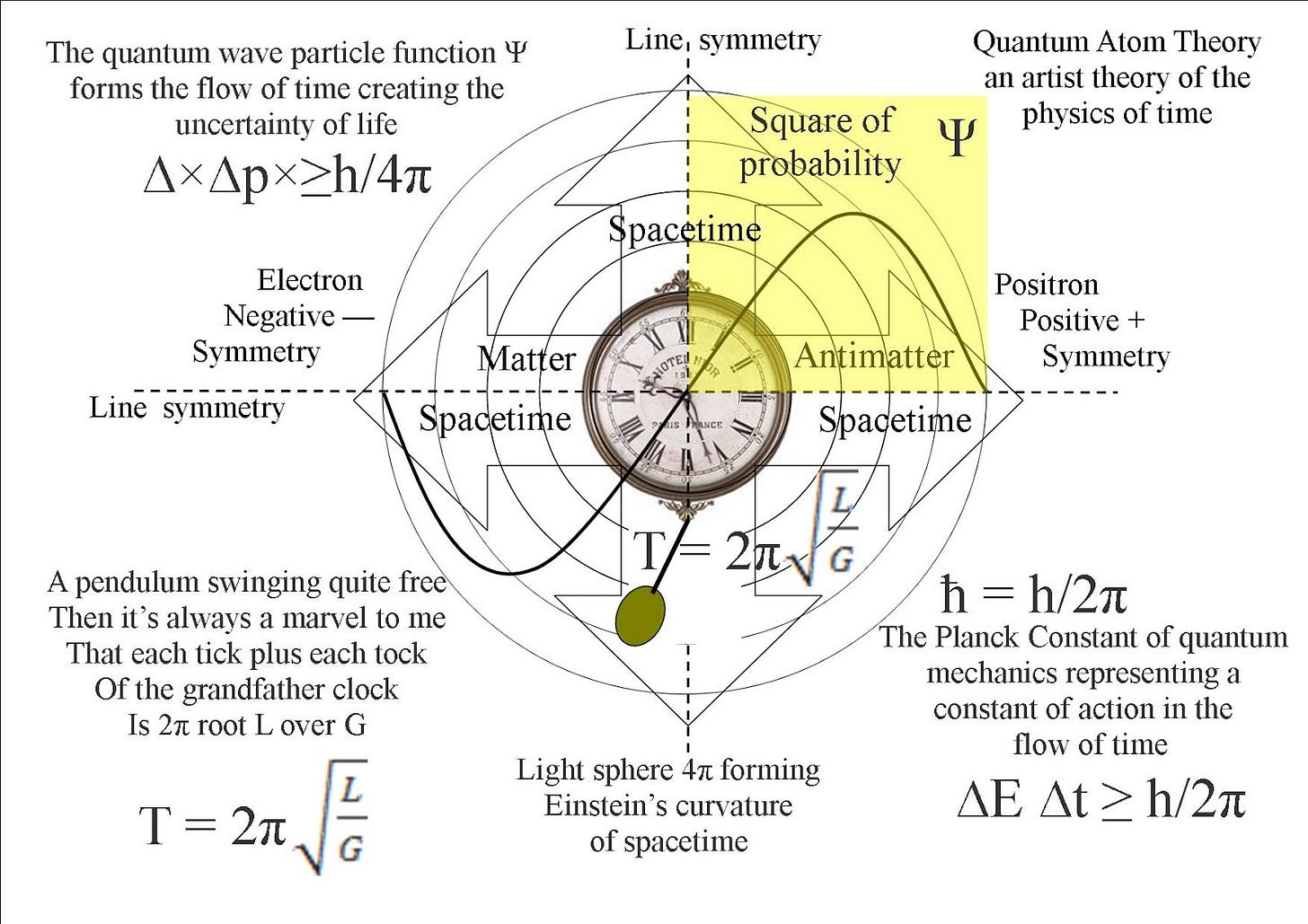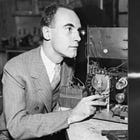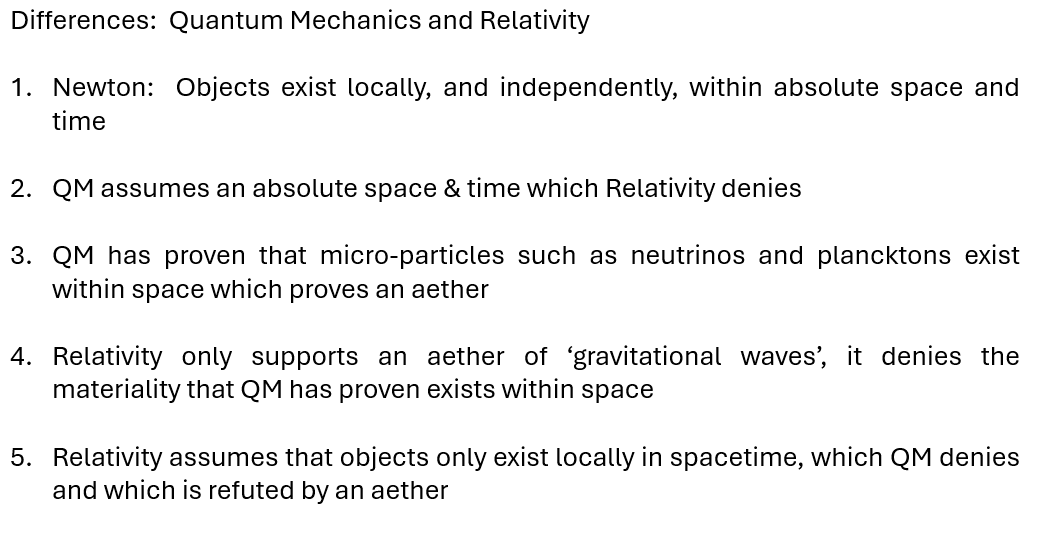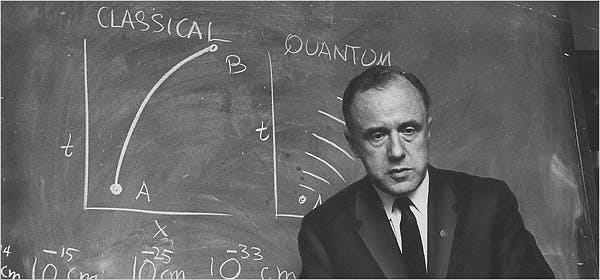The Aether of Quantum Mechanics, which nullifies Relativity and Einstein's gravity theory. Not that anyone discusses such things.
QED and the world of Plancktons is just another nail in Einstotle's Relativity coffin.
Brian Greene, “We then encounter subsequent discoveries that transformed the question once again by redefining the meaning of “empty,” envisioning that space is unavoidably suffused with what are called quantum fields and possibly a diffuse uniform energy called a cosmological constant – modern echoes of the old and discredited notion of a space-filling ether.”1
Doomed
Relativity is doomed on many fronts. One frontal assault which Einstein vigorously opposed was the 1920’s discovery or creation of quantum mechanics or QM and QED or quantum electro-dynamics. QM proposes a ponderable substance to space, in lieu of Einstein’s amorphous vacuum or ‘Relativistic Aether’, which as past posts outlined, is a seminal manipulation of rhetoric and theory without proofs.
QM nullifies Relativity, though AI and modern apologia will object (using word salads such as ‘nuanced’, ‘relativistic’ and appealing to ‘consensus’). Any ponderable substance in space which is more than just a ‘wave of gravity’ disproves Relativity. Today, physical theorists en-masse know that inner and outer space hold a vast array of particles and/or fields. Einstein as was so often the case, was once again completely wrong.
Particles that are identified within ‘space’ include:
Neutrinos2, cosmic rays, radiation, gravitons, maximons, positrons and electropons, machions, etherons, axions, newtonites, higgsionos, fermions, bosons, to name a few.
A vacuum does not exist. Yet this is taught and repeated in the ‘science media’. For a long time, even back to the Medieval period, it has been surmised and is now known, that space is composed of a world with infinitesimally small molecules of functional dimensions. Descartes’ ‘whirlpool’ or vortices redolent with matter. One physicist describes it:
“Classically, a vacuum is simply the absence of matter. In quantum mechanics, however, the [Heisenberg] uncertainty principle leads us to view the vacuum as a very complex system…The vacuum, then, is more like a pan of popcorn than a featureless, empty sea. Particle-antiparticle pairs pop into existence here and there, but disappear quickly”.3
There appears to be a micro-world of particle- antiparticle pairs including electropons. Quantum mechanics can only measure the effects of such particles. It does not really know what the particles are, nor can it accurately predict what these particles will do in every case (as opposed to being able to predict what atoms will do). As noted above, quantum scientists refer to them as particles that ‘pop in and out of existence’.4
The First Law of Thermodynamics cannot be violated, but how the pop-in, pop-out-of-existence works in reality is unknown, except as past posts have stated, that positrons (antimatter) and matter itself must be made from the aether through the interaction of material energy.
· space is composed of a lattice of very stable electron- positron pairs,
· when the proper quanta of radiation are administered, these pairs will either temporarily deform the lattice or jolt the electrons and positrons out of alignment and release them
QM and Relativity
Acclaimed physicist and Nobel laureate Robert Laughlin links the anti-materiality of the aether back to QM:
“The existence and properties of antimatter are profoundly important clues to the nature of the universe….The simplest solution – and the one that turned out to be experimentally correct – was to describe space as a system of many particles similar to an ordinary rock. This is not a precisely correct statement, since Paul Dirac formulated the relativistic theory of the electron
…but in hindsight it is clear that they are exactly the same idea…. This…has the fascinating implication that real light involves motion of something occupying the vacuum of space….The properties of empty space relevant to our lives show all the signs of being emergent phenomena characteristic of a phase of matter.”5
The vacuum of space is perforce an aether full of material, fields, energy and a micro-world that is barely understandable to modern physics. To try and describe this aether-world, the idea of Planck particles or ‘plancktons’ is used. This is a dimensional model named after the physicist Max Planck due to his formulation of the quantum ħ, the smallest unit of energy.
Planckton particles have lengths as small as 10-33 cm; mass as ethereal as 10-5 grams; and time as short as 10-44 seconds. Comparing the Planck length to the size of an atom (10-13 cm) or an electron (10-20 cm), a Planck particle (‘planckton’) is 100 billion billion times smaller than an atom, and 1 million million times smaller than an electron! If an atom was the size of a basketball, a planckton would be about the size of the electrons in the basketball.6
Hawking & the Uncertainty Principle
How can something so small be identified? QM’s own physics and logic leads to the conclusion that the aether of space is full of such material. Relativity acolyte Stephen Hawking illustrates the point:
“[T]he uncertainty principle means that even “empty” space is filled with pairs of virtual particles and antiparticles…(unlike real particles, they cannot be observed directly with a particle detector)….If it weren’t – if “empty” space were really completely empty – that would mean that all the fields, such as the gravitational and electromagnetic fields, would have to be exactly zero.
However, the value of a field and its rate of change with time are like position and velocity of a particle: the uncertainty principle implies that the more accurately one knows one of these quantities, the less accurately one can know the other. So if a field in empty space were fixed at exactly zero, then it would have both a precise value (zero) and a precise rate of change (also zero), in violation of that principle. Thus there must be a certain minimum amount of uncertainty, or quantum fluctuations, in the value of the field.”7
Hawking is of course wrong about virtual particles. These particles must be real or the aether does not function and light, energy, gravitation would have no medium in which to operate. He is right in that quantum field fluctuations are now a part of the ‘standard model’ of astrophysics. Such fluctuations obviously have a material genesis. Modern science interprets the appearance and disappearance of electropon pairs to be an example of the creation and annihilation of matter and they make a similar interpretation in explaining why plancktons appear and disappear in 10-44 seconds.
Wheeler, foam and Planck dimensions
In 1957, Princeton professor John Wheeler modeled micro-particle phenomena as ‘space-time foam’, or a universe of ‘virtual’ particles appearing and disappearing in Planck time through blackholes.8 Ironically, Wheeler was also quoted as saying that blackholes were ‘the greatest crisis ever faced by physics.’9 It is unlikely that blackholes exist.
Based on the quote above Stephen Hawking supported Wheeler’s theory, stating that, on extremely small scales in the Planck dimensions, space is alive with “turbid random activity and gargantuan masses,” while “wormholes” provide passage to other universes.10 There are many issues with wormholes and blackholes, but at least Relativists like Hawking were and are slowly drawn to the light of aether reality.
· Other physicists such as Ian Redmount and Wai-Mo Suen speak of ‘quantum space-time foam’ or ‘Lorentizian space-time foam’ (other words for an aether),11 as does S. J. Prokhovnik.12
· F. Selleri understands the CMB as the fundamental reference frame (an aether), pointing out that any object that travels through it (the aether), is affected by radiation pressure.13
· Jean-Pierre Vigier refers to a ‘non-empty vacuum’ (another word salad for aether), and outlines the phenomenon of superluminal interactions in an ‘underlying deterministic substructure.’14 Vigier points to the experiments by Alain Aspect, which confirm the results.15
Robert Moon, professor emeritus in physics at University of Chicago, adds:
“According to accepted theory, free space is a vacuum. If this is so, how can it exhibit impedance? But it does. The answer, of course, is that there is no such thing as a vacuum, and what we call free space has structure. The impedance equals 376+ ohms.”16
Impedance means a mismatch or misalignment. There is a space and time impedance, or an ‘Ohms’ (electrical current) impedance (Z₀). This means that there is a discrepancy in the fundamental physical constant that relates the electric and magnetic fields of electromagnetic radiation (like light) propagating through ‘free space’.
In other words, the electro-magnetic impedance means that free space does not exist. There is an aether which of courses disproves Relativity.
Einstein’s gravity disproved (again)
The aether and its mélange of super small particles may also help to explain the still unknown physical process in gravity. In 1948 Hendrik Casimir discovered that two mirrors facing each other in a perfect vacuum have a mysterious force acting upon them that draws them together, which is appropriately called “the Casimir effect.”17
This is a force that seems to appear out of nowhere, since in a vacuum there would be no obvious forces or material substances carrying them, yet a force was registered. Bernard Haisch, editor of the Astrophysical Journal, theorized that the Casimir effect shows the existence of a ‘zero-point field’ from the gap between the plates.18 Though likely misleading, Haisch knows something is there, and it is far smaller than the dimensions seen on the atomic level.
Given all of the above, and given that QM is broadly considered the most important discovery by modern physics, many physicists now comprehend that it is long overdue to rubbish Einstein’s theories about gravity.19
QM’s discoveries spell a certain doom for the theories of Einstein because, try as they may, no one will ever be able to bridge the huge gap between Relativity and the Quantum world in which these particles are created and catalogued (see image above and differences).
Roger Penrose, the celebrated physicist secure enough in his own stature to speak his mind, has stated that the concept of ‘space-time’ may be eliminated from the basis of physical theory altogether.20 Others believe that at the Planck scale, the concept of space-time is replaced by a network of what can be termed ‘loops and knots’ of energy. This theory has been elaborated by A. Ashketar, Carlo Rovelli, Lee Smolin and a few others.21
There are also issues with QM as outlined here:
Common Sense
Common sense and physics clearly indicates that the spacetime merger is a fantasy and vitiates real science. QM observations nullify the gravitational and spacetime theories of Einstotle. No wonder he fought against QM.
Particles at planck dimensions seem to inhabit everything that happens in the universe. Obtaining the right understanding of this Planck universe will inevitably reduce and make irrelevant, both Relativity and Quantum Mechanics. This has been known for quite a long time. Even staunch Relativists admit this eventuality. As Alan Kostelecký wrote in Scientific American: “The observable effects of Planck-scale Relativity violations are likely to lie in the range of 10-34 to 10-17.” 22
In QM physics, short distance and short times correspond to high momenta and high energies. Therefore, at sufficiently high energy, or ‘Planck energy’, a particle should ‘see’ the graininess of spacetime. That violates relativity, which depends on spacetime being smooth down to the tiniest size scales. It predicts the same doom, however, for Quantum Mechanics itself:
“Still, something is rotten in the state of quantumland, too. As Einstein was among the first to realize, quantum mechanics, too, is incomplete. It offers no reason for why individual physical events happen, provides no way to get at objects’ intrinsic properties and has no compelling conceptual foundations.” 23
The above quote and critique seems reasonable. No one has much of a clue how the aether works, or the incredibly small micro world of plancktons and other particles.
Bottom Line: Relativity violated
We can conclude that ‘The Science’ finds itself in a real pickle jar.
Relativity is rubbished at many levels of course, the coup de grace so to speak, delivered by QM. But even QM has its own issues. Theories which play in word games and delve into ‘virtual particles’ (or foam, non-empty vacuum etc), understand that they are also ruined. Redmount and Suen have shown that if ‘virtual’ plancktons are left in the ‘pop in and pop out’ category, numerous anomalies appear in the structure of the quantum field, including but not limited to ‘wormholes’ on an intolerable scale. Wormholes and blackholes are unproven and might not exist, extensive panegyrics to the contrary.
The far simpler and more realistic position is that plancktons and other super-micro materials are real particles and inform a real aether which must exist to transfer light, energy, gravity and radiation. This annihilates so to speak Relativity and its spacetime fantasy. It is also quite likely overturns parts of QM or forces QM into further modifications to accomodate plancktons for example.
The aether truth is so glaring, so fearsome, so gigantic for ‘The Science’, that few within its billions-of-$-per year-industry, want to discuss or analyse it.
All hail.
===
1String theorist Brian Greene, The Fabric of the Cosmos, 2004, Preface, p. x. Brian Greene has also written the popular book, The Elegant Universe.
2 Josef Tsau, Discovery of Aether and its Science, 2005. It is Tsau’s belief that a neutrino wind generated by the Sun pushes the planets in their orbital paths, thereby answering the mysterious phenomenon of inertia. He writes: “The high energy neutrino particles produced by the dense-matter object of the Sun affected by its rapid rotation and the strong force fields created by the rotation may form a constant spiral neutrino-particle wind that provides a directional pushing effect only, which may cause the outer layer of the Sun to rotate and is utilized by all planets to stay in orbit. If a planet is orbiting in the right direction, such a spiral wind at equilibrium would constantly give it a push in both its orbiting and anti-gravity directions to keep it in orbit” (p. 22).
3James Trefil, “The Accidental Universe,” Science Digest, June 1984, p. 100
4 “…according to quantum mechanics, empty space is not empty. Rather, the vacuum is filled with fields and particles that constantly pop in and out of existence. The problem is that when physicists estimate how much energy is contained within those fields and particles, they come up with a number…that is insanely large, 10120 times greater than what we observe” (Discover, October 2005, p. 56).
5 Robert B. Laughlin, A Different Universe, pp. 103-105.
6 The Planck length is derived from the formula √(Għ/c3), where G is the gravitational constant, ħ is Planck’s constant of angular momentum, and c is the speed of light. This may be the fundamental length that would prohibit further division on an actual, not potential, basis. See V. L. Ginzburg, Key Problems of Physics and Astronomy, Moscow, Mir Publishers, 1976.
7 Hawking, A Briefer History of Time, pp. 122-123.
8 John A. Wheeler and C. M. Patton, “Is Physics Legislated by Cosmology?” The Encyclopedia of Ignorance, editors: Ronald Duncan and Miranda Weston-Smith, Pocket Books, 1978, pp. 19-35.
9 “Those Baffling Black Holes,” Time, Sept. 4, 1978. In another venue, Wheeler commented: “To me, the formation of a naked singularity is equivalent to jumping across the Gulf of Mexico. I would be willing to bet a million dollars that it can’t be done. But I can’t prove that it can’t be done” (Computer Defies Einstein’s Theory, by John Wilford, New York Times, March 10, 1991).
10 Black Holes and Baby Universes and Other Essays, Bantam, 1994; A Briefer History of Time, pp. 104-123.
11 Physical Review D, 3rd series, vol. 47, No. 6, March 1993; I. Redmount and W.-M. Suen, “Is Quantum Spacetime Foam Unstable?” Rapid Communication, Physical Review D, 47, 2163 (1993); “De Broglie Waves on Dirac Ether,” Lettere Al Nuovo Cimento, vol. 29, No. 14, Dec. 1980; W.-M. Suen, “Minkowski Spacetime is Unstable in Semi-Classical Gravity,” Physical Review Letters, 62, 2217 (1989).
12 S. J. Prokhovnik, “Light in Einstein’s Universe,” Dordrecht, Reidel, 1985; “A Cosmological Basis for Bell’s View on Quantum and Relativistic Physics,” in Bell’s Theorem and the Foundation of Modern Physics, eds., A. Van der Merwe, F. Selleri, G. Tarozzi, New Jersey, World Scientific, 1990, pp. 508-514.
13 F. Selleri, “Space-time Transformations in Ether Theories,” Z. Naturforsch, 46a, 1990, pp. 419-425.
14 J. P. Vigier, “Causal Superluminal Interpretation of the Einstein-Podolsky-Rosen Paradox,” and “New non-zero photon mass interpretation of Sagnac effect as direct experimental justification of the Langevin paradox,” Physics Letters A, 234, 1997, pp. 75- 85; Physics Letters A 175, 1993, p. 269.
15 Physical Review Letters, vol. 49, No. 2, July 12, 1982.
16 “Space Must Be Quantizied,” 21st Century, May-June, 1988, p. 26ff.
17 Hendrik B. G. Casimir, Proc. Kon. Ned. Akad. Wetensch. B51, 793, 1948
18 Physical Review, (B. Haisch, A. Rueda, and H.E. Puthoff, Physical Review A, 49, 678, 1994.
19 H. Yilmaz, “Towards a Field Theory of Gravitation,” Il Nuovo Cimento, Vol. 107B, no. 8, 1991; I. Peterson, “A New Gravity? Challenging Einstein’s General Theory of Relativity,” Science News, Vol. 146, 1994; J. P. Siepmann, “The Laws of Space and Observation,” Journal of Theoretics, Vol. 1, No. 1, 1999.
20 Roger Penrose, The Road to Reality: A Complete Guide to the Laws of the Universe, New York, Alfred Knoph, 2005, pp. 968-1002
21 Lee Smolin, “Atoms of Space and Time,” Scientific American, Sept. 2004; A. Ashtekar, V. Husain, J. Samuel, C. Rovelli, L. Smolin: “2+1 quantum gravity as a toy model for the 3+1 theory,” Classical and Quantum Gravity 6, L185, 1989; C. Rovelli: “Loop space representation In: New perspectives in canonical gravity”
22 Alan Kostelecký, “The Search for Relativity Violations, “ Scientific American, September 2004, p. 96.
23 George Musser, “Was Einstein Right,” Scientific American, Sept. 2004, p. 89









Its ironic since Einsteins Relativity was the source of quantum physics.
Abandoning the aether gave rise to the idea of disembodied waves and so the wave-particle duality of photons was born. Leading us inexorably towards insanity.
If we accept that Einstein was a fraud and that his theories are metaphysical nonsense, then quantum physics disappears too.
Everything is resolved, aether physics can begin and perhaps we can develop space propulsion.
I assume this poison pill was introduced to slow down development because rapid scientific progress destabilised the control of religious institutions.
In a percieved observable phenonemon existence, there is no nothing.
EVERYTHING has an observable phenonemon.
"That about wraps it up for Einstein."
"it's spoon fed science, without the spoon" 😂
Cheers
Michael.